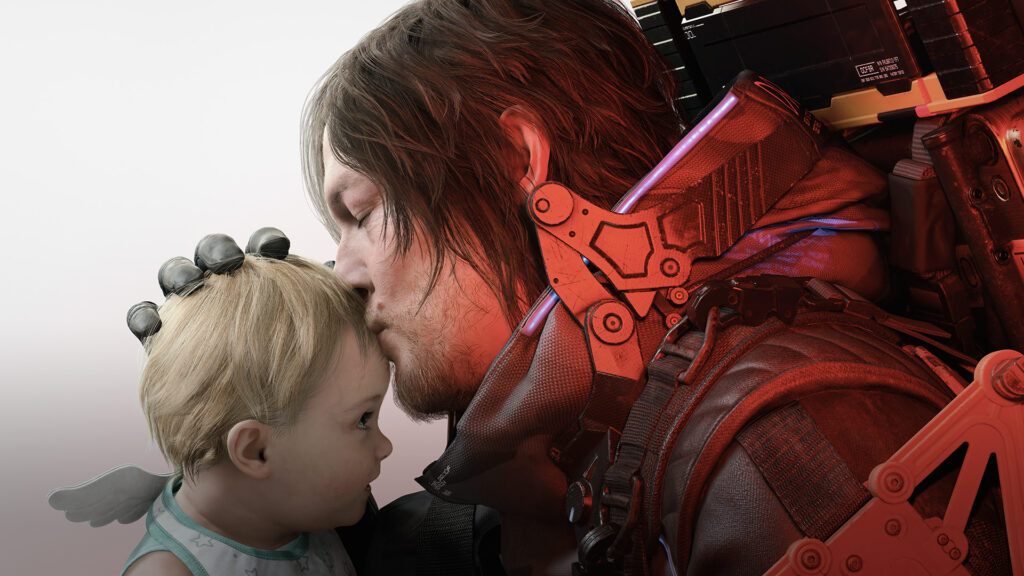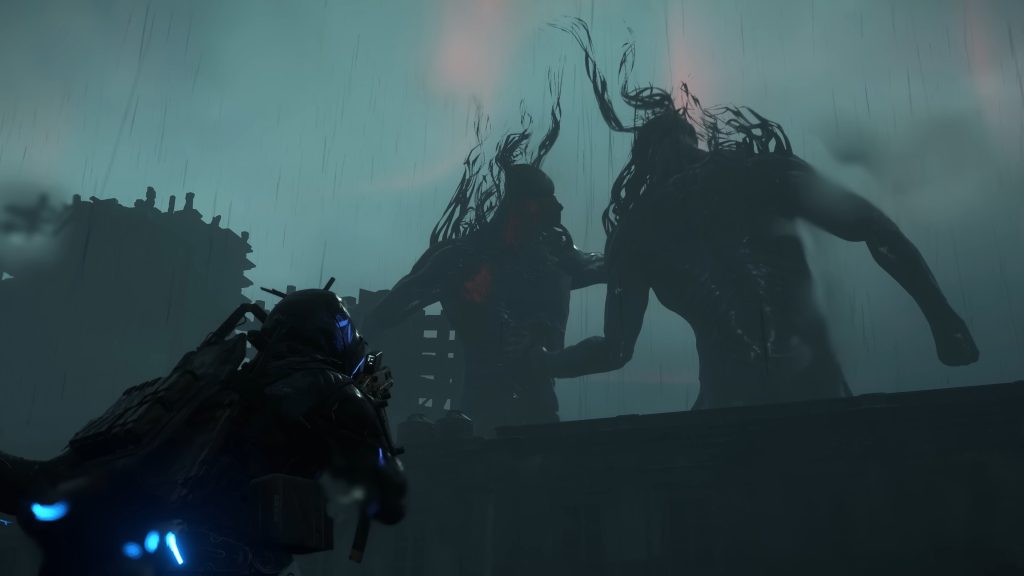A True Current-Gen Visual Showcase

D019’s Death Stranding was easily one of the most unique games of the last generation, and it’s no surprise that it came from Kojima Productions. Death Stranding dumped players into an isolated world, and tasked them with making deliveries and, in doing so, bringing people back together. The beauty of Death Stranding lies in how it was able to convert such a menial task of going from point A to B into the central part of the gameplay, and after much anticipation, the sequel is finally here.
Death Stranding 2 takes what worked in the original, and expands the net of ideas to wider horizons that fans will surely appreciate. But how does it build upon the past from a technical aspect? With this feature, we will be trying to answer that very question as we dive deep into this post post-apocalyptic world.
What’s New In The Decima Engine?
Much like its predecessor, Death Stranding 2 is built on the Decima Engine which was created by Guerilla Games. We have seen some impressive visuals in the latest rendition of Horizon Forbidden West, but that was still a cross-generation release, which meant that the technology wasn’t really pushed to the fullest. But with Death Stranding 2, we are going to see the first current-generation implementation of Decima Engine and the results are striking.
Decima Engine was always a powerhouse when it came to rendering huge landscapes, and those strengths are taken to the next level with Death Stranding 2.
Right from what looks to be a new global illumination solution to cutting-edge animation work and huge draw distances, there’s a lot that makes the world of Death Stranding 2 so special, and we will be discussing all of this in detail in the next section.
Lighting and Global Illumination

Starting things off with global illumination, Death Stranding 2 showcases a highly dynamic and realistic lighting system based on our observation. There are plenty of convincing scenes that suggest the game uses advanced real-time lighting techniques, though some elements may still rely on traditional rasterized methods. With the inclusion of a dynamic day and night cycle, it makes sense that the developers have moved away from baked lighting or other static approaches in favor of a more fluid and reactive solution. The dynamic lighting is surprisingly accurate, and indirect reflections look superb in both indoor and outdoor spaces.
The GI implementation also helps in achieving accurate ambient occlusion, ensuring that self-reflections and detailing remain on point for all objects. Similarly, shadows are also cast realistically thanks to indirect lighting data and bounce lighting, producing accurate shadows. The quality of shadows is also of an appropriately high quality, helping to give the world of Death Stranding 2 some depth that makes the presentation quite endearing.
Character Rendering

The character rendering pipeline boasts cutting-edge technology, which results in characters that look significantly better than before. The skin meshes are realistic with distinct textures, and the hair rendering does a great job of rendering thousands of fine hair strands and simulating movement without visible artifacts. Clothes also showcase current-gen material rendering that accurately reacts to light, and there are plenty of neat flourishes that one can notice such as eye reflections, fur rendering on clothing, and more.
Environmental Detail and Terrain

Environment is easily one of the biggest aspects of Death Stranding 2’s presentation, and the sequel is showing some great improvements in this regard. The game features a vast array of terrain types, ranging from deserts to rivers and snowcapped peaks, and so much more – and the best part is that it doesn’t compromise on quality.
There’s a surprising amount of geometric complexity in the terrain, and that gives the world a lot of character. Assets also boast great polycounts, and the aforementioned lighting system comes together to create some truly stunning vistas.
The Decima Engine has made huge strides in the cloud rendering department with its Nubis system, and Death Stranding 2 uses that to its advantage. From realistic cloud formations to dense smoke volumes, they look quite realistic and reactive, making the world of Death Stranding 2 look like what might just be one of the best on the market.
These advancements also extend to other aspects of the presentation, such as fluid simulation in water. Just notice how realistically the water flows – not just in rivers, but also during floods as it rolls over the ground, destroying bridges and other formations in its path. The world of Death Stranding 2 is a lot more reactive thanks to its systemic nature, and you can see several similar technical flourishes throughout the land.
Terrain appears to deform naturally as you walk through the path, snow realistically accumulates in puddles, showcasing advanced decal mechanisms, and extreme weather conditions like high heat are simulated through haze effects.
Streaming, Draw Distance And More

The post-processing pipeline truly shines in Death Stranding 2, right from chromatic aberration (used sparingly) to particle effects and volumetric lights.
Death Stranding 2 is an open-world game, so it’s only natural that a solid world streaming system should be in place for a smooth loading experience. And thankfully, the Decima Engine makes good use of current gen tech to create such cohesive systems. The draw distance is quite massive, and the world streaming system doesn’t chug under the heavy weight of high-quality assets or effects. The world exhibits a consistently high level of detail for objects far from the camera, complete with shadow effects that make for a rather consistent feel in the environments.
We also get to see some great use of modern upscaling techniques to bring to life a rather crisp image that rarely falters. The anti-aliasing pass seems to be of the MSAA kind with a sharp presentation, and that’s topped up with what looks to be an FSR implementation.
PS5’s Graphical Options:

Much like the predecessor, we get to see two distinct graphics options – Fidelity, which aims for native 4K with 30fps lock, and a performance mode that targets upscaled 4K with a frame cap of 60fps.
There isn’t much of a fundamental difference in how the image is rendered. The feature set remains the same in both cases, but Performance mode seems to dial back the texture quality and rendering distance by some margin along with a lower target resolution – but the upscaling implementation does a good job of smoothing those edges out without any significant artifacting.
Performance Mode is clearly the better way to play. Both modes look great, but that’s largely thanks to the game’s strong art direction, which makes excellent use of its carefully crafted assets. I didn’t notice any frame rate drops in either mode, so performance remains rock-solid across the board. However, gameplay feels noticeably smoother and more responsive in Performance Mode, and the visual trade-offs are minimal.
Animation and Motion

Just notice how Sam, our protagonist, naturally moves about the environment. Right from how accurately the feet and steps change from a brisk walk to sprinting or how the feet adapt to an uphill climb, there’s no shortage of distinct animations in Death Stranding 2. There’s also a tangible heft to every movement, but that doesn’t compromise on the reactiveness of the inputs, so you always feel like you are in control.
The sequel also places a lot more emphasis on the combat, and Death Stranding 2’s set of combat animations are also similarly dynamic with frames looking pretty realistic while also blending into one another. When it comes to animations, Death Stranding 2 is easily one of the best in its class. Character models look absolutely superb during cutscenes, beautifully capturing every little movement and expression from the actor to the model. Of course, it doesn’t just end here but naturally extends to how the characters move about during gameplay.
Audio Evolution

Another standout feature is evident in how Death Stranding 2’s tracks work. Much like how Red Dead Redemption 2’s soundtrack dynamically retains its intensity to match the gameplay, Death Stranding 2 features many variants of the same song which change depending on gameplay parameters and significantly enhances the sense of impact – be it a soft hum to accompany your treks or a thunderous ballet of instruments when you find yourself in the middle of an earthquake or a fight.
The audio has also seen some improvements in the sequel; Death Stranding 2 makes good use of the PS5’s Tempest Engine to produce 3D audio that simulates a real world setting. Different objects emit distinct audio signatures from across the game world, and they are transmitted to the player in a realistic fashion. Audio detailing is also fine-grained to a meticulous degree, and every object generates sounds ranging from individual enemies to a single rain drop.
Conclusion
To conclude, Death Stranding 2 is definitely an impressive piece of technology; it feels like a complete package. Kojima Productions has made great use of current-gen technology, not just in the graphics department but also the 3D audio to deliver something that feels like the fully realized vision of Death Stranding. It definitely shares the same DNA as its predecessor, but the incremental upgrades in each aspect do build up to create a significant improvement in the final product.




